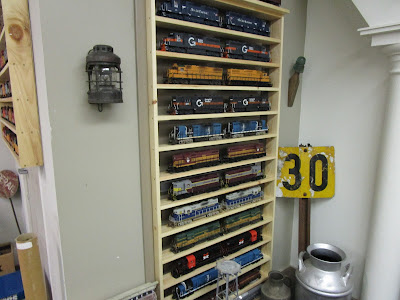Several years ago I saw an advertisements for Model Rail Scenes, a company that custom builds train layouts. They seemed to focus mainly on three rail O scale layouts, and their work was realistic and evocative of New England scenery. At the time, I decided that if I ever did build an O scale layout I would want mine to focus on the northeast. So I called the owner, Brian Inch, just to talk about basic layout concepts and such. I wasn't planning on hiring him to build a layout for me, but he models things I haven't seen elsewhere and I wanted to pick his brain. He did one better, and invited me to visit his showroom and talk with him in person. Great!... except he was 330 miles away in Augusta, Maine.
I also had a desire to revisit the WW&F Railway in Alna, Maine. I am a lifetime member of the railroad organization but hadn't been there in person since 2017.
With these two Maine destinations in my mind I just decided to go for it. The pandemic was a still a big thing at that time and I had a lot of free time. My daytrip was on a Saturday and in 11+ hours I covered almost 700 miles. I woke up early and left the house at 6:00 AM exactly. I arrived back home at 10:45 PM. But, aside from waiting in line for over 2 hours at Red's Eats for a fried chicken sandwich (which sadly I found out they were out of when I got to the front of the line!) it was a good day. Below are some pictures from my trip.
Brian's workshop display layout is 10x16', and there is a lot packed in it. It is considered an "island" style layout in that you can walk completely around it. I really liked his dock scene.
This bridge took up a lot of space but it wasn't forced into the scene, and that is what made it so realistic. Many bridges are shoehorned in by builders who want add them just because they look good without giving thought to whether the rest of the scenery would demand such a bridge be built there.
The center area is part of his old display layout that I actually saw at the Springfield, MA train show a couple of years ago. Even the tree-covered forests look good and they aren't those cheap "puff ball trees" that everyone seems to like to build.
Around the layout area were display shelves filled with O scale trains that would have run on railroads in Maine. It was inspiring to see. Brian told me he did a lot of custom painting to get the trains he wanted.
Another interesting view.
After we talked for a while, I said goodbye and drove to the WW&F Railway. They were running multiple trains which required passing each other at the station stop in Alna Center. More picture of my visit can be found here.
As part of my NMRA Master Model Railroader program, I scratchbuilt an On2 model of T.C.D.A. #65. While in town, I set my own boxcar next to the real thing in Wiscasset, ME. and took a picture.
It was a great day and I had fun talking with Brian and riding the WW&F. What I didn't realize was that my journey into O scale would begin so soon after visiting.
























